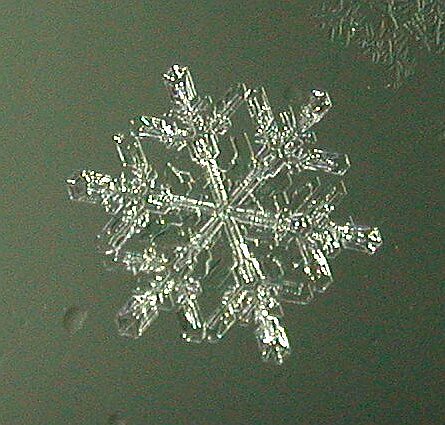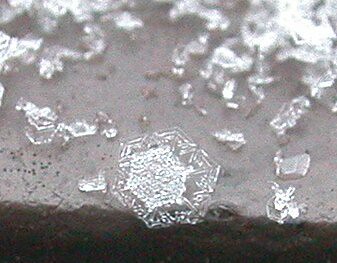Tuesday, January 18, 2005
Me and Pramila
Some times it is so strange that you just meet once and you still remember that person. You wish to meet that person again and again and there is some magnetism which drags you towards them.
I met Pramila in a fellowship potluck party.I agreed to go to the party to please my former roommate Saweda. There I had met Pramila.
After that meetign it was hard to get in touch. We often promised to but were unable to make it.
At last, last Sunday we were able to meet for a brief time before she could leave Iowa city and go to Boston to study Ministry.
Well, I am neither into Christianity nor am a religious person.But I do consider myself spiritual. I really felt that spiritual touch when I met Pramila last time.
Here is Swapna cheering good bye and all the best to Pramila.
Take care my friend.
Friday, January 14, 2005
More on snowflakes
The conditions of the form of snowflake
Clouds are made up of water vapour and composed of very tiny water droplets. In continental clouds, most droplets are smaller than one of seven hundredth of an inch chay to S.I. unit 0.04 millimetre in diameter. Many people believe that when the temperature gets below 0°C, the water will freeze. However, it is not always the case. Most scientists believe that the basic process is like the following.
Normally, water droplets will not stick with each other, unless there are some conditions satisfied. First of all, the temperature of the atmosphere is around the freezing temperature of water which is 0°C. However, pure water droplets will not automatically condense in such temperature. It is because water droplets do not contain a special kind of particle, which is the second condition, called a condensation nucleus. Most of the freezing nuclei are at about -10°C and allow the cloud droplets to condense around them. In the sky, if water droplets freeze, they must need something to stick to. Dust is the material that is the easiest found in the atmosphere. Smog, or even bacteria, can act as the freezing nuclei too.
A group of Soviet scientists did a research and their results and confirmed the above explanation. They used aircrafts to release man-made particles made of dust in the sky. Then they collected and measured the ice nuclei (freezing nuclei). It showed that in the presence of those man-made particles, the size of the snow crystal were considerably bigger than natural one.
The process of snowflake formation
When the temperature is below 0°C and in the presence of freezing nuclei, the water droplets begin to freeze and become ice crystals. As those water droplets are too tiny to see, many people mistake this process as sublimation, by which the water vapour skips the liquid state and turns directly into ice.
When ice crystals begin to form, water droplets around those ice crystals will freeze and cling with them together. As they continue to grow, they attract more water droplets and expand to form larger sizes. When they join with around 2 to 200 ice crystals, they will become unique shape of snowflakes depending on the condition of the atmosphere.
Snow particles fall at rates ranging from nearly zero for tiny crystals to about a metre per second for a typical snowflake and several times larger for melting snow. When snow crystals strike supercooled droplets, the droplets will immediately freeze onto them. This process, called riming, forms soft particles known as snow pellets or grains. In temperate zones, the melting of snow pellets provides much of the rainfall from cumulus clouds.
When ice crystal grows, it attracts more and more water molecules to form snowflakes. A construction mystery of snowflakes is the average hexagonal shape, which may contain as many as 100 million or more water molecules. In certain conditions, the growing process proceeds in both perfectly horizontal and perpendicular directions, thus building a broader and thicker crystal in hexagonal symmetry. Amazingly, this symmetry is always maintained out when the size is increased.
Growth of Snowflake
When snow forms, the atmosphere is saturated with water vapour and the temperature should be below 0°C. Tiny ice crystals begin to form around the freezing nuclei. Then, ice crystals join together and snowflakes are formed. This process is called crystallization. During crystallization, the water molecules will change from liquid state to solid state with their most basic alignment. As the basic form of ice crystals is a hexagonal prism, most ice crystals are six-sided in shape at the beginning. When more water molecules join the ice crystals, they will build up around the first hexagon and maintain the shape of the crystal as it grows.
Although most ice crystals are formed in six-sided symmetry, the crystals can result in many different shapes which depend mostly on temperature. If the temperature is lower than -30°C, the ice crystals will form with hexagonal columns. At around -15°C, the ice crystals will form with hexagonal plates which are the typical flat snowflakes we see. When the temperature is up to around -5°C, needles shaped crystals and many other undetermined shaped crystals appear. As the higher the clouds, the lower the temperature. So in high clouds, six-sided hexagonal columns are more common. Flat hexagonal plate snowflakes are formed in the middle clouds while many different shapes of crystals are formed in the low clouds. However, the real situation is much more complex and the whole picture is still not well understood.
Size of Snowflake
Many people think that snowflakes are of snow faller from the sky and so they think that snowflakes are as large as a snowball. Actually, the term snowflake refers to an individual snow crystal, while snow falling from the sky are called snowballs which include hundreds or even thousands of small snowflakes stuck together. Now, you can imagine how small snowflakes are.
Snow crystals are typically between 0.5 to 3 millimetres in diameter whereas snowflakes are about 10 mm in size. Snowflakes weigh around 1 gram per 3000 to 10000 snowflakes. Some large snowflakes may typically be as large as 200 to 400 mm (0.79 to 1.57 inches), but occasionally some giants may also form. Exceptionally large snowflakes can exceed 500 mm (2 inches) and contain hundreds of individual crystals. For a snowflake to grow to an exceptionally large size, conditions must be perfect. Besides having ideal temperature for stickiness, the winds must not too strong or else the large flakes will break up as they fall.
Snowflakes form when air temperature near the earth's surface is not far from the freezing point. Snows crystals adhere to one another better within this temperature range. At very cold temperatures, snowflakes are uncommon, and snow comprises mainly snow crystals. According to a research, when the temperature is -36°C, the average size of snow crystal is 0.017 square millimetres. At -24°C the average size is 0.034 square millimetres. At -18°C, the average sizes is increased to 0.084 square millimetres. At -6°C the average sizes is 0.256 square millimetres. At -3°C the average size of snow crystals can be as big as 0.811 square millimetres.
Six-side structure of snowflakes
We know that the hexagonal shape of snow crystals can be classified into two main types: plate-like and column-like. The beautiful snowflakes that we usually see have basic plate-like with 6-side symmetries. They usually form under temperature between -5°C to - 20°C. The column-like forms include needles or hollow columns. Needle shape crystals form between 0°C to -5°C while hollow column form below -20°C.
If we want to understand why most ice crystals are hexagonal prisms, we should study water molecules first. Water molecules are made of two hydrogen atoms and one oxygen atom (that is why we sometimes call water H2O). They stick together by a strong bonding called covalent bond.
When water cools to freezing point, the water molecules collide together to form solid ice crystals. They form a bond called a hydrogen bond that is strong enough to stick the two water molecules together. When molecules stick together, they form the most stable arrangement. In water molecules, the most stable arrangement consists of six water molecules forming a hexagonal shape. That is why most ice crystals have 6-side symmetry.
When more water molecules from the surroundings stick to the ice crystals, most of them will stick to the corners of the hexagonal ice crystal plate. It is because the corners are easier to attract water molecules than the edges. So, a snowflake will always grow from its corners.
Uniqueness of Snowflakes
Long time ago, a scientist did a research about snowflakes. He used microscopes to examine the shape of around 5000 snowflakes. To his amazement, he found that no two snowflakes were exactly the same shape. Each snowflake has its own unique pattern.
Scientists tried to solve the mystery of snowflakes. They discovered that snowflakes are extremely sensitive to the change of atmospheric conditions. A small change in temperature or humidity can bring about an abrupt change in the growth pattern of snowflakes. In the atmosphere, the temperature and the humidity are constantly changing. That is why it is difficult to find two snow crystals that are exactly alike.
In fact, the sharpness of snowflakes reflects its growth conditions. For example, when we see a snowflake with plate-like shape and needles-like arms, we can guess that when this snowflake was formed, the temperature was between -5°C and - 20°C so that a plate-like ball could be generated, and then the temperature got warm to between 0°C and -5°C for it to get the needle arms. Also, the longer the snowflake drifting in the skies, the more complicated its resulting shape.
For more detailed information just follow the link http://www.lcsd.gov.hk/CE/Museum/Science/temp-exh/flowers/efj32.htm#section5
Snow Snow everywhere
Iowa City looks like a wonderland. A beautiful town covered with ice. The temperatures are less than minus and everyone complains about the wind chills. However at times you do enjoy the beautiful surroundings. I like it especially when we have very light showers of snowfall. You have all the snow flakes settling on your dark coat which draws your attention. The temperature is also not that low and the snowflakes drag your attention making you feel more warmer and happier. I love the different patterns of snowflakes on my coat and try to examine each of their patterns. Do you know that no single snow flake is the same? Yeah, it is true. Each one has its own unique pattern :).
I came up this interesting link which had lovely patterns of snowflakes.
For all the snowflake lovers here is a wonderful link. Enjoy viewing them:)
http://images.google.com/imgres?imgurl=http://www-2.cs.cmu.edu/~zhuxj/astro/images/atmosphere/misc/snowflakes/snowflakes030126a.jpg&imgrefurl=http://www-2.cs.cmu.edu/~zhuxj/astro/html/snowflakes.html&h=263&w=337&sz=25&tbnid=wZBz1UJbdBEJ:&tbnh=89&tbnw=114&start=569&prev=/images%3Fq%3Dsnowflakes%26start%3D560%26hl%3Den%26lr%3D%26sa%3DN
Wednesday, January 12, 2005
Winter blues
Last winter started with a very exciting note when I was really eagerly waiting to experience the snowfall. The feeling of experiencing a snowfall was so romantic and exciting. I always loved those beautiful mountains and plains covered with snow on the television and in movies and I always wished to be there experiencing the same. When my roommate warned me of the first snowfall last winter, she told me to be careful while walking and also told me to stay indoors as much as possible. It is going to be bad tomorrow. "Better wear your warmest Jacket and cover yourself as much as possible,” she said. "Wow it's going to snow? Hmm I am surely going to play outside and make a snow man,” I said. "Sure my dear, I can very well understand your excitement. Let me see how long this lasts" said Vaidarbhi with a mischievous smile.
Well, she wasn't wrong. After all that warnings from my roommate and others I decided to stay indoors to enjoy the snowfall. I did wish to go out to make a snow man but was feeling so uncomfortable with the cold weather. However as time passed by, everything became banal and I hardly enjoyed the winter. Moreover the chill winds really used to irritate my skin and make me uncomfortable. I was very anxiously waiting for the summer to arrive.
This is my second winter in Iowa and I am already worried of getting up early in the morning. I just hope this semester passes out very quickly and the winter is not too severe. Meanwhile I met a fresher who just arrived last fall. This is going to be her first winter and I can very well see the excitement in her eyes. I could do nothing but just smile at her. It won’t be long before she starts disliking winter and the snow.


